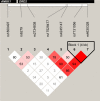Posttraumatic Brain Injury Cognitive Performance Is Moderated by Variation Within ANKK1 and DRD2 Genes
- PMID: 25931179
- PMCID: PMC4626432
- DOI: 10.1097/HTR.0000000000000118
Posttraumatic Brain Injury Cognitive Performance Is Moderated by Variation Within ANKK1 and DRD2 Genes
Abstract
Objective: As dopamine neurotransmission impacts cognition, we hypothesized that variants in the linked dopamine D2 receptor (DRD2) and ankyrin repeat and kinase domain (ANKK1) genes might account for some individual variability in cognitive recovery following traumatic brain injury (TBI).
Participants: Prospective cohort of 108 survivors of severe TBI, recruited consecutively from a level 1 trauma center.
Design: We examined relationships between DRD2 genetic variation and functional recovery at 6 and 12 months post-TBI.
Main measures: Cognitive performance was evaluated using 8 neuropsychological tests targeting different cognitive domains. An overall cognitive composite was developed using normative data. We also assessed functional cognition, depression status, and global outcome. Subjects were genotyped for 6 DRD2 tagging single-nucleotide polymorphisms and Taq1A within ANKK1.
Results: ANKK1 Taq1A heterozygotes performed better than homozygotes across several cognitive domains at both time points postinjury. When adjusting for age, Glasgow Coma Scale score, and education, the Taq1A (ANKK1) and rs6279 (DRD2) variants were associated with overall composite scores at 6 months post-TBI (P = .0453 and P = .0452, respectively). At 12 months, only Taq1A remained a significant genetic predictor of cognition (P = .0128). Following multiple-comparisons correction, there were no significant associations between examined genetic variants and functional cognition, depression status, and global outcome.
Conclusion: These data suggest that genetic variation within DRD2 influences cognitive recovery post-TBI. Understanding genetic influences on dopaminergic systems post-TBI may impact current treatment paradigms.
Figures



Similar articles
-
COMT and ANKK1 Genetics Interact With Depression to Influence Behavior Following Severe TBI: An Initial Assessment.Neurorehabil Neural Repair. 2016 Nov;30(10):920-930. doi: 10.1177/1545968316648409. Epub 2016 May 6. Neurorehabil Neural Repair. 2016. PMID: 27154305 Free PMC article.
-
Single nucleotide polymorphisms in ANKK1 and the dopamine D2 receptor gene affect cognitive outcome shortly after traumatic brain injury: a replication and extension study.Brain Inj. 2008 Aug;22(9):705-14. doi: 10.1080/02699050802263019. Brain Inj. 2008. PMID: 18698520 Free PMC article.
-
DRD2 C957T polymorphism is associated with improved 6-month verbal learning following traumatic brain injury.Neurogenetics. 2017 Jan;18(1):29-38. doi: 10.1007/s10048-016-0500-6. Epub 2016 Nov 8. Neurogenetics. 2017. PMID: 27826691 Free PMC article.
-
The effect of ANKK1 Taq1A and DRD2 C957T polymorphisms on executive function: A systematic review and meta-analysis.Neurosci Biobehav Rev. 2019 May;100:224-236. doi: 10.1016/j.neubiorev.2019.01.021. Epub 2019 Mar 2. Neurosci Biobehav Rev. 2019. PMID: 30836122
-
Ankyrin Repeat and Kinase Domain Containing 1 Gene, and Addiction Vulnerability.Int J Mol Sci. 2020 Apr 4;21(7):2516. doi: 10.3390/ijms21072516. Int J Mol Sci. 2020. PMID: 32260442 Free PMC article. Review.
Cited by
-
COMT and ANKK1 Genetics Interact With Depression to Influence Behavior Following Severe TBI: An Initial Assessment.Neurorehabil Neural Repair. 2016 Nov;30(10):920-930. doi: 10.1177/1545968316648409. Epub 2016 May 6. Neurorehabil Neural Repair. 2016. PMID: 27154305 Free PMC article.
-
TBI Rehabilomics Research: an Exemplar of a Biomarker-Based Approach to Precision Care for Populations with Disability.Curr Neurol Neurosci Rep. 2017 Sep 19;17(11):84. doi: 10.1007/s11910-017-0791-5. Curr Neurol Neurosci Rep. 2017. PMID: 28929311 Review.
-
Impact of Traumatic Brain Injury on Dopaminergic Transmission.Cell Transplant. 2017 Jul;26(7):1156-1168. doi: 10.1177/0963689717714105. Cell Transplant. 2017. PMID: 28933212 Free PMC article. Review.
-
Genetic variation and dopamine D2 receptor availability: a systematic review and meta-analysis of human in vivo molecular imaging studies.Transl Psychiatry. 2016 Mar 1;6(3):e747. doi: 10.1038/tp.2016.22. Transl Psychiatry. 2016. PMID: 26926883 Free PMC article.
-
Subjective Cognitive Decline and Related Cognitive Deficits.Front Neurol. 2020 May 19;11:247. doi: 10.3389/fneur.2020.00247. eCollection 2020. Front Neurol. 2020. PMID: 32508729 Free PMC article. Review.
References
-
- CDC - TBI - TBI in the US Report. at > http://www.cdc.gov/traumaticbraininjury/tbi_ed.html<.
-
- Fleming Jennifer, Tooth Leigh, Mary Prediction of community integration and vocational outcome 2-5 years after traumatic brain injury rehabilitation in Australia. Brain Inj. 1999;13:417–431. - PubMed
-
- Levin H, Benton A, Grossman RG. Neurobehavioral Consequences of Closed Head Injury. Oxford University Press; 1982.
-
- Bayley MT, et al. INCOG Guidelines for Cognitive Rehabilitation Following Traumatic Brain Injury: Methods and Overview. J. Head Trauma Rehabil. 2014;29:290–306. - PubMed
Publication types
MeSH terms
Substances
Grants and funding
LinkOut - more resources
Full Text Sources
Research Materials

